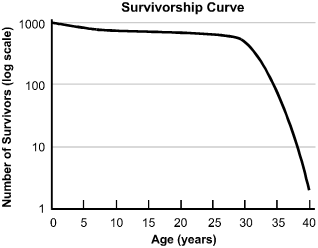Recommendation for individuals using a screenreader: please set your punctuation settings to "most."
Descriptive Statements:
- Analyze the interactions of biotic and abiotic factors that limit or regulate population size, including the difference between density-independent and density-dependent factors.
- Analyze the behavior of organisms and the relationship of behavior to various social systems.
- Analyze demographic characteristics, life history patterns, population growth curves, and survivorship curves for populations occurring in different habitats and under different conditions.
- Analyze the composition of biological communities, the types of relationships that exist among organisms in communities, the concept of ecological niche, and factors that produce change in communities.
Sample Item:

The horizontal axis is labeled "Age (years)" and has values marked from 0 to 40 in increments of 5. The vertical axis is labeled "Number of Survivors (log scale)" and has values marked at 1, 10, 100, and 1000, with the distance between each of the values the same. The curve begins at (0, 1000), descends gradually to approximately (32, 800), and then drops steeply to approximately (40, 2).
What does the survivorship curve shown above indicate about a population made up of
individuals with an average life expectancy of 40 years?
- The greatest increase in survivorship occurs at the end of the lifespan.
- Members of the population are most vulnerable during infancy.
- The population has a low mortality rate during middle age.
- Individuals begin reproduction very early in the lifespan.
Correct Response and Explanation (Show Correct ResponseHide Correct Response)
C. This question requires the examinee to analyze demographic
characteristics, life history patterns, population growth curves, and survivorship
curves for populations occurring in different habitats and under different conditions.
The graph shown is an example of a Type I survivorship curve, reflecting low death
rates at early and middle ages and a steeper drop-off in old age.
Descriptive Statements:
- Analyze energy flow and biogeochemical cycling in ecosystems.
- Demonstrate knowledge of different types of biomes, their geographical distribution and physical characteristics, and their typical flora and fauna.
- Analyze the trophic roles of organisms in different ecosystems.
Sample Item:
Which of the following would most likely increase the amount of phosphorus available to
organisms in an ecosystem?
- the burning of fossil fuels
- the rising of air temperature
- the cultivation of leguminous plants
- the weathering of rocks
Correct Response and Explanation (Show Correct ResponseHide Correct Response)
D. This question requires the examinee to analyze energy flow and
biogeochemical cycling in ecosystems. Of the possible responses, only the weathering
of rocks would increase the availability of phosphorus to organisms because the largest
reservoir of phosphorus is in sedimentary rocks of marine origin.
Descriptive Statements:
- Analyze the effects of human activities on aquatic populations, communities, and ecosystems, and the implications of these effects for humans and other organisms.
- Analyze the effects of human activities on terrestrial populations, communities, and ecosystems, and the implications of these effects for humans and other organisms.
- Analyze the effects of human activities on the atmosphere and climate and the implications of these effects for humans and other organisms.
Sample Item:
Scientists have observed reduced fertility in a variety of aquatic animals including fish,
reptiles, and insects in waterways near urbanized or agricultural areas. This reduction in
fertility rates is most likely a result of:
- an increase in the number of invasive species present in degraded habitats.
- a disruption of endocrine systems caused by the introduction of natural hormones and synthetic compounds.
- a decline in the quantity and quality of food resources needed to sustain reproduction.
- an interruption of mating behaviors and the destruction of breeding sites caused by human activity.
Correct Response and Explanation (Show Correct ResponseHide Correct Response)
B. This question requires the examinee to analyze the effects of human
activities on the atmosphere and climate and the implications of these effects for humans
and other organisms. The introduction of endocrine disrupters into wetlands and waterways
negatively affects the reproduction, growth, and development of wildlife, especially
carnivorous animals. Widely publicized examples of endocrine disrupters include DDT and
PCBs, but human medicines and cosmetics are now also known to interfere with the functioning
of hormones and endocrine glands in seals, fish, alligators, and snails, for example.